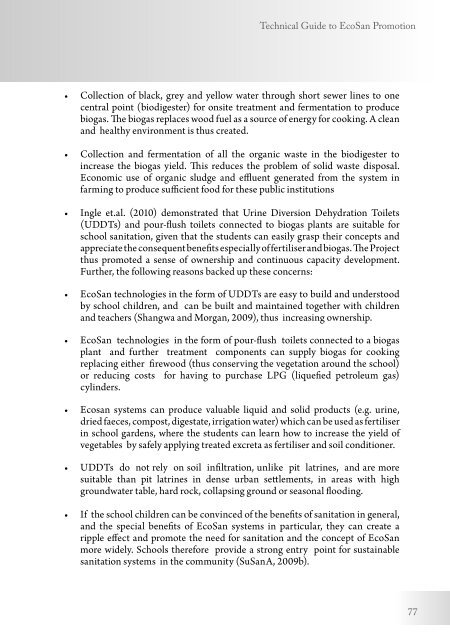Technical Guide to EcoSan Promotion
Technical Guide to EcoSan Promotion
Technical Guide to EcoSan Promotion
You also want an ePaper? Increase the reach of your titles
YUMPU automatically turns print PDFs into web optimized ePapers that Google loves.
<strong>Technical</strong> <strong>Guide</strong> <strong>to</strong> <strong>EcoSan</strong> <strong>Promotion</strong><br />
• Collection of black, grey and yellow water through short sewer lines <strong>to</strong> one<br />
central point (biodigester) for onsite treatment and fermentation <strong>to</strong> produce<br />
biogas. The biogas replaces wood fuel as a source of energy for cooking. A clean<br />
and healthy environment is thus created.<br />
• Collection and fermentation of all the organic waste in the biodigester <strong>to</strong><br />
increase the biogas yield. This reduces the problem of solid waste disposal.<br />
Economic use of organic sludge and effluent generated from the system in<br />
farming <strong>to</strong> produce sufficient food for these public institutions<br />
• Ingle et.al. (2010) demonstrated that Urine Diversion Dehydration Toilets<br />
(UDDTs) and pour-flush <strong>to</strong>ilets connected <strong>to</strong> biogas plants are suitable for<br />
school sanitation, given that the students can easily grasp their concepts and<br />
appreciate the consequent benefits especially of fertiliser and biogas. The Project<br />
thus promoted a sense of ownership and continuous capacity development.<br />
Further, the following reasons backed up these concerns:<br />
• <strong>EcoSan</strong> technologies in the form of UDDTs are easy <strong>to</strong> build and unders<strong>to</strong>od<br />
by school children, and can be built and maintained <strong>to</strong>gether with children<br />
and teachers (Shangwa and Morgan, 2009), thus increasing ownership.<br />
• <strong>EcoSan</strong> technologies in the form of pour-flush <strong>to</strong>ilets connected <strong>to</strong> a biogas<br />
plant and further treatment components can supply biogas for cooking<br />
replacing either firewood (thus conserving the vegetation around the school)<br />
or reducing costs for having <strong>to</strong> purchase LPG (liquefied petroleum gas)<br />
cylinders.<br />
• Ecosan systems can produce valuable liquid and solid products (e.g. urine,<br />
dried faeces, compost, digestate, irrigation water) which can be used as fertiliser<br />
in school gardens, where the students can learn how <strong>to</strong> increase the yield of<br />
vegetables by safely applying treated excreta as fertiliser and soil conditioner.<br />
• UDDTs do not rely on soil infiltration, unlike pit latrines, and are more<br />
suitable than pit latrines in dense urban settlements, in areas with high<br />
groundwater table, hard rock, collapsing ground or seasonal flooding.<br />
• If the school children can be convinced of the benefits of sanitation in general,<br />
and the special benefits of <strong>EcoSan</strong> systems in particular, they can create a<br />
ripple effect and promote the need for sanitation and the concept of <strong>EcoSan</strong><br />
more widely. Schools therefore provide a strong entry point for sustainable<br />
sanitation systems in the community (SuSanA, 2009b).<br />
77

















